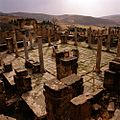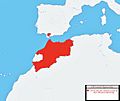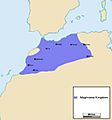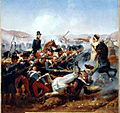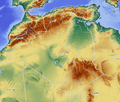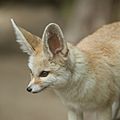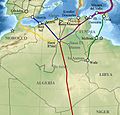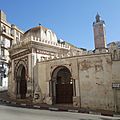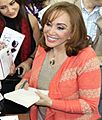Algeria facts for kids
Quick facts for kids
People's Democratic Republic of Algeria
الجمهورية الجزائرية الديمقراطية الشعبية (Arabic)
al-Jumhūriyyah al-Jazāʾiriyyah ad-Dīmuqrāṭiyyah ash‑Shaʿbiyyah |
|
|---|---|
|
Motto: بِالشَّعْبِ و لِلشَّعْبِ
Bi-sh-shaʿb wa li-sh-shaʿb "By the people and for the people" |
|
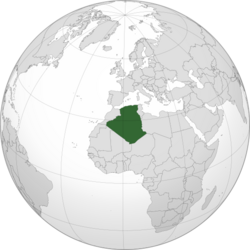 |
|
| Capital and largest city
|
Algiers 36°42′N 3°13′E / 36.700°N 3.217°E |
| Official languages |
|
| National vernacular | Algerian Arabic |
| Foreign languages | French English |
| Ethnic groups | See Ethnic groups |
| Religion
(2012)
|
|
| Demonym(s) | Algerian |
| Government | Unitary semi-presidential republic |
| Abdelmadjid Tebboune | |
| Sifi Ghrieb | |
|
• Council President
|
Azouz Nasri |
| Legislature | Parliament |
| Council of the Nation | |
| People's National Assembly | |
| Formation | |
|
• Numidia
|
202 BC |
|
• Kingdom of Tlemcen
|
1235 |
| 1516 | |
| 5 July 1830 | |
| 5 July 1962 | |
| Area | |
|
• Total
|
2,381,741 km2 (919,595 sq mi) (10th) |
| Population | |
|
• 2025 estimate
|
47,400,000 (33rd) |
|
• Density
|
19/km2 (49.2/sq mi) (206th) |
| GDP (PPP) | 2025 estimate |
|
• Total
|
|
|
• Per capita
|
|
| GDP (nominal) | 2025 estimate |
|
• Total
|
|
|
• Per capita
|
|
| Gini (2011) | 27.6 low |
| HDI (2023) | high · 96th |
| Currency | Algerian dinar (DZD) |
| Time zone | UTC+1 (CET) |
| Calling code | +213 |
| ISO 3166 code | DZ |
| Internet TLD |
|
Algeria, officially known as the People's Democratic Republic of Algeria, is a large country in North Africa. It is the biggest country in Africa. Its name comes from its capital city, Algiers.
Algeria shares borders with the Mediterranean Sea to the north. It is also next to Tunisia, Libya, Niger, Mauritania, Mali, Western Sahara, and Morocco.
Contents
Algeria's Past: A Quick Look
People have lived in Algeria for a very long time, possibly since 10,000 BC. You can see signs of this ancient life in Tassili National Park. Around 600 BC, people from Phoenicia settled in places like Tipaza.
Later, in the mid-7th century, the first Muslim Arabs arrived. Many people in Algeria chose to follow this religion. In the 11th century, Arab tribes like the Banu Hilal moved into the region.
Did you know that the famous mathematician, Fibonacci, lived in Algeria as a teenager? This is where he learned about the Hindu-Arabic number system, which helped him create the number system we use today!
In the 1500s, Algeria became part of the Ottoman Empire. During this time, pirates from the Barbary Coast were active in the area.
Becoming Independent
France took control of Algeria in 1830. For many years, Algerians wanted their freedom. In 1954, the National Liberation Front (FLN) started a war to gain independence from France. This war lasted several years.
Finally, Algeria became independent on July 5, 1962. The next year, Ahmed Ben Bella became the first President of Algeria.
From 1991 to 2002, Algeria went through a difficult period known as the Algerian Civil War. In 2011, after many protests, the government ended a long-standing state of emergency.
Land and Nature
A huge part of southern Algeria is covered by the Sahara Desert. This desert makes up more than four-fifths of the country's total area.
In the north, you'll find mountain ranges like the Aures and Nememcha. The highest point in Algeria is Mount Tahat, which stands at 3,003 meters (9,852 feet) tall.
Languages Spoken
The official languages of Algeria are Arabic and Berber. Many people also speak French.
People and Cities
Algeria has a population of about 39.5 million people. There are over 40 cities in the country with more than 100,000 residents.
Regions of Algeria
Algeria is divided into 48 areas called provinces. These divisions have been in place since 1983.
|
|
UNESCO World Heritage Sites
Algeria is home to several UNESCO World Heritage Sites. These are special places recognized for their cultural or natural importance:
- Al Qal'a of Beni Hammad: This was the first capital of the Hammadid empire.
- Tipasa: An ancient town that was first Phoenician and later Roman.
- Djémila and Timgad: Both are impressive ruins from the Roman era.
- M'Zab Valley: A unique valley with a large, green oasis town.
- The Casbah of Algiers: An important historic fortress in the capital city.
- Tassili n'Ajjer: A mountain range that is Algeria's only natural World Heritage Site.
Fun Facts About Algeria
- Algeria is the only country whose national anthem mentions the names of two other countries.
- The national animal of Algeria is the fennec fox, a small desert fox with large ears.
- The capital city, Algiers, has the tallest minaret (a tower on a mosque) in the world, standing 870 feet tall.
- The U.S. Army once imported camels from Algeria!
- Two Nobel Prize winners are from Algeria: Albert Camus for literature and Claude Cohen Tannoudji for physics.
- Part of the original 1932 Tarzan movie was filmed in Algeria.
- The Sahara desert covers more than 80% of Algeria's land.
- Algerians often invite friends to share tea as a sign of welcome.
- The national dish of Algeria is couscous, a popular North African food.
Images for kids
-
Masinissa (c. 238–148 BC), first king of Numidia
-
The lands which comprise modern day Algeria were part of the Byzantine Empire (The empire in 555 under Justinian the Great, at its greatest extent since the fall of the Western Roman Empire (vassals in pink))
-
Bombardment of Algiers by the Anglo-Dutch fleet, to support the ultimatum to release European slaves, August 1816
-
Emir Abdelkader, Algerian leader insurgent against French colonial rule, 1865
-
The six historical Leaders of the FLN: Rabah Bitat, Mostefa Ben Boulaïd, Didouche Mourad, Mohammed Boudiaf, Krim Belacem and Larbi Ben M'Hidi.
-
The Sahara, the Hoggar Mountains and the Atlas Mountains compose the Algerian relief.
-
The fennec fox is the national animal of Algeria
-
Hassan Pasha Mosque in Oran
-
Algerian musicians in Tlemcen, Ottoman Algeria; by Bachir Yellès
-
Ahlam Mosteghanemi, the most widely read female writer in the Arab world.
-
A Bulgur-based salad
See also
 In Spanish: Argelia para niños
In Spanish: Argelia para niños




